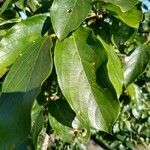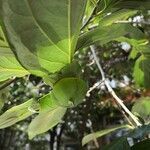Trees, to 27 m tall, deciduous. Young branchlets densely pubescent to glabrous, sometimes with reddish brown lenticels. Winter buds small, blackish. Petiole 0.8--2 cm; leaf blade lanceolate, elliptic, or ovate, occasionally obovate, 5--18 X 2.6--9 cm, papery, pubescent when young drying brown, adaxially often glabrescent when mature and paler with dark veinlets, base cuneate, subtruncate, or rarely cordate, apex usually acuminate, lateral veins 5--7 per side, reticulate veinlets clearly defined, flat, and dark. Male flowers small, in 3--5-flowered cymes; calyx ± as long as corolla, hairy on both sides, lobes 4; corolla white, yellowish white, or red, 6--10 mm; stamens (14--)16--24. Female flowers solitary; calyx 3 cm or more in diam., lobes 4; corolla usually yellowish white, campanulate, (0.9--)1--1.6 cm, lobes recurved and ovate; staminodes 8(--16); ovary glabrous or pubescent. Fruiting calyx 3--4 cm in diam. Berries yellow to orange, flattened globose to ovoid but usually globose, 2--8.5 cm in diam., 8-locular, glabrescent. Seeds dark brown, 13--16 X 7.5--9 X 4--5 mm. Fl. May-Jun, fr. Sep-Oct.
More
A tree up to 12 m high which loses its leaves each year. The branches tend to hang over and they have a dense covering of leaves. Leaves are long and pointed (10 x 6 cm). The leaves are dark green and shiny on top and lighter under. Young leaves are pale green and old leaves turn yellow or red before they fall. Male and female flowers are normally on separate tree. Therefore pollinator trees often help. Sometimes male and female flowers occur on the same tree. Fruit are 7 cm across, with flattened ends and orange with a thin skin. It can have a few large seeds inside or be seedless. Pollination and seeding influence flavour and fruit ripeness. There are many varieties. Fuya cultivated varieties are eaten when firm and Hachiya cultivated varieties when very ripe.
It suits cooler Mediterranean type climates. In the tropics it needs to grow in highland areas with a distinctly seasonal climate. Dormant trees can tolerate freezing temperatures. They have only a short (100 hours) chilling requirement. It needs 890 hours between 8-12°C during the dormant period. They will not tolerate acid soils. A pH of 6.5 to 7.5 is preferred. They can stand some waterlogging. It does best in well drained soils. Branches tend to be brittle and damaged by strong winds. In Nepal it grows to about 1200 m altitude. In Indonesia it grows above 1,000 m above sea level. In Yunnan in China it grows between 600-1800 m above sea level. It grows in secondary forest. It suits hardiness zones 8-10. In Brisbane Botanical Gardens. Arboretum Tasmania.
More
Not known in a truly wild situation, it is found in broad leafed woodland but probably as an escape from cultivation.
Not known in a truly wild situation, it is found in broad leafed woodland but probably as an escape from cultivation.
The fruit is eaten raw or can be cooked. It needs to be fully ripe and soft. Freezing fruit overnight can improve sweetness. They are used in pies, puddings, cakes, bread, ice cream and other desserts. Fruit can be stored frozen. Fruit are used for wine and vinegar. The leaves are used to improve the flavour of pickled radishes. Roasted seeds are served as a coffee substitute.
They are grown from seeds. Seeds often germinate poorly. Trees grow slowly. Budded or grafted trees can be used. They can be grown by cuttings and air-layering. Trees can be pruned and shaped either along a wall or as a hedge. Pruning when trees are young to develop a strong framework of branches is important. Adequate moisture is needed during the year. Trees can grow and produce with minimal fertiliser. Trees often need cross pollination from another tree.









